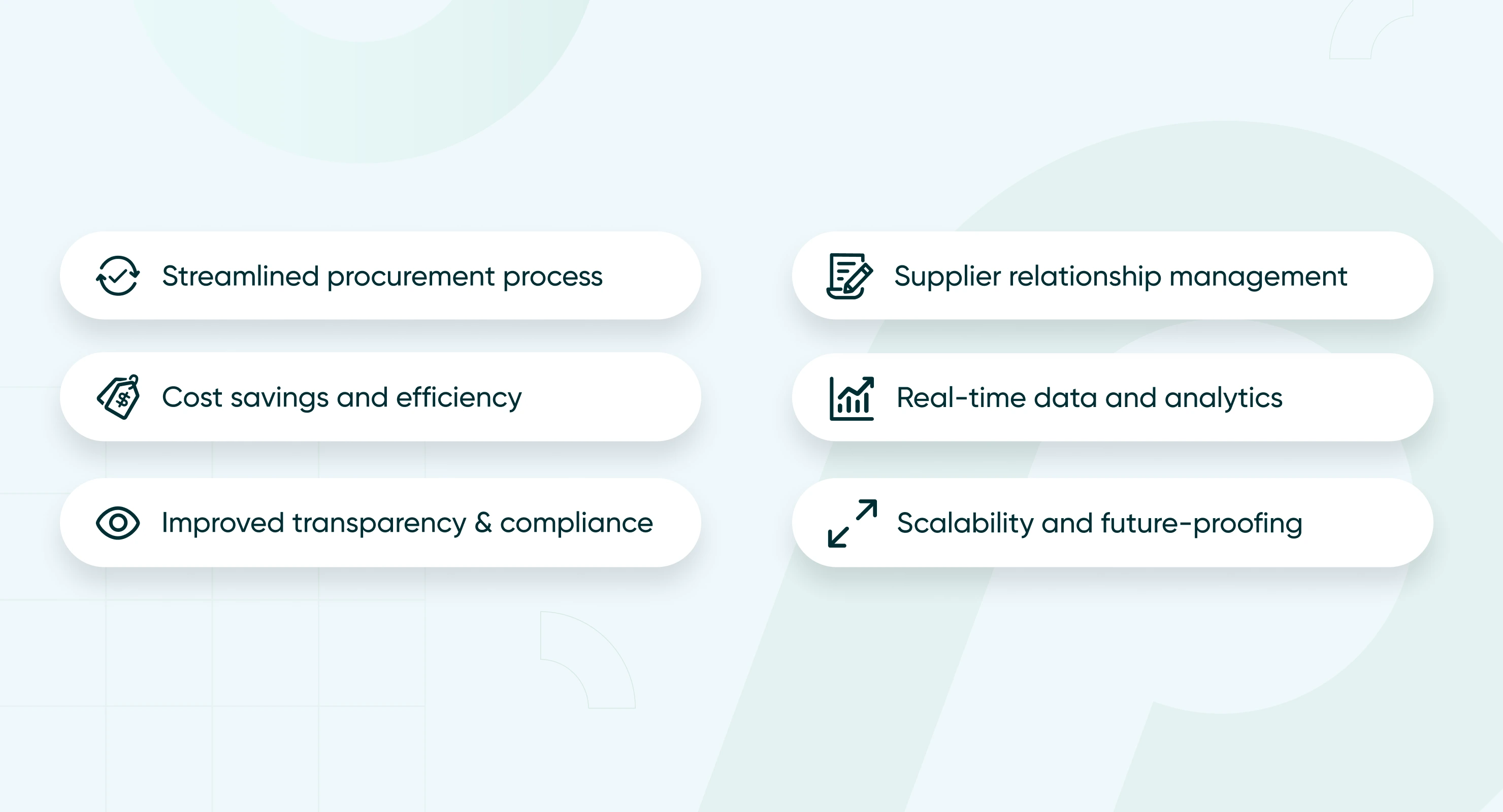
6 Benefits of Adopting an E-Procurement Process
The compounding cost of a poor procurement process is steep.
An disorganized organization with largely manual processes can incur unnecessary costs, delays, and missed opportunities. This makes it extremely challenging for companies to streamline operations, reduce overhead, and make data-driven decisions.
This is where e-procurement steps in—a digital solution that transforms the way organizations manage their purchasing activities.
E-procurement, short for electronic procurement, leverages technology to automate and enhance the procurement process. It eliminates manual paperwork, provides real-time access to data, and ensures greater transparency throughout the purchasing cycle. Whether you’re managing purchase orders, engaging with suppliers, or tracking spending, e-procurement delivers a more efficient, reliable, and scalable approach.

Ready for unparalleled visibility and control over your spend?
Book a personalized demo to see how Procurify helps finance leaders make data-informed decisions with real-time budget visibility.
In this article, we’ll explore the top 6 benefits of adopting an e-procurement process and why it’s becoming a must-have for businesses looking to stay competitive.
1. Streamlined procurement process
One of the most significant advantages of e-procurement is its ability to streamline the entire procurement workflow. Traditional procurement processes are often plagued by inefficiencies—manual data entry, slow approval cycles, and fragmented communication. These issues can lead to delays, errors, and frustration for both the procurement team and stakeholders.
With an e-procurement system, every stage of the procurement process—from requisition to purchase order creation, approval, and payment—can be automated. By reducing manual touchpoints, e-procurement minimizes the risk of human error and speeds up approval cycles. Procurement teams can track every step of the process in real-time, ensuring that bottlenecks are quickly identified and addressed.
For example, instead of handling paper forms or emailing back and forth for approvals, all relevant parties can review and approve requests digitally in a centralized platform. This leads to faster turnaround times and greater transparency, allowing procurement teams to focus on more strategic tasks rather than being bogged down in administrative work.
2. Cost savings and efficiency
Cost savings are a primary driver for businesses considering the transition to an e-procurement system. By automating procurement processes, companies can significantly reduce operational costs associated with manual tasks, paperwork, and inefficiencies.
One of the key ways e-procurement achieves this is by minimizing administrative overhead. Traditional procurement methods often involve lengthy processes, requiring staff to spend hours on tasks such as data entry, invoice management, and supplier communication. With e-procurement, many of these tasks can be automated, freeing up valuable time for procurement professionals to focus on strategic initiatives.
E-procurement platforms also provide greater visibility into spending patterns, enabling organizations to identify areas where they can negotiate better terms or consolidate purchases. For instance, bulk purchasing can lead to substantial discounts, and having a clear view of supplier performance allows companies to make informed decisions about supplier selection.
Additionally, e-procurement systems often integrate with budgeting and financial software, which helps organizations keep track of spending in real time. This integration aids in avoiding budget overruns and ensuring that procurement decisions align with financial goals.
3. Improved transparency and compliance

In the world of procurement, transparency and compliance are essential for maintaining trust and accountability. E-procurement systems significantly enhance both by providing a clear, auditable trail of all purchasing activities. This increased visibility is crucial for organizations aiming to adhere to regulatory requirements and internal policies.
With traditional procurement methods, tracking and documenting every step of the process can be cumbersome and prone to error. E-procurement platforms, however, automatically record every transaction, from requisition to payment, in a centralized database. This not only makes it easy to access historical data but also simplifies the auditing process. Procurement teams can quickly generate reports to demonstrate compliance with relevant regulations and internal controls.
E-procurement systems often include built-in compliance checks that enforce company policies during the purchasing process. For instance, approvals can be required at various stages based on the purchase amount or the type of goods being procured. This ensures that all purchases are vetted appropriately, reducing the risk of unauthorized spending.
Additionally, enhanced transparency promotes better supplier relationships. With clearer communication channels and real-time access to procurement data, both buyers and suppliers can collaborate more effectively. This openness fosters trust and accountability, which are vital for long-term partnerships.
In conclusion, adopting an e-procurement process not only improves transparency and compliance but also instills a culture of accountability within the organization. Leveraging technology creates a clear audit trail and enforce procurement policies.
4. Supplier relationship management
Effective supplier relationship management is critical to the success of any procurement strategy. E-procurement systems enhance this aspect by facilitating better communication, collaboration, and data sharing between organizations and their suppliers.
One of the key benefits of e-procurement is the ability to centralize supplier information in one accessible platform. This includes contact details, performance metrics, pricing agreements, and historical purchase data. With all this information at their fingertips, procurement teams can make more informed decisions when selecting and negotiating with suppliers.
E-procurement platforms often provide tools for managing supplier performance, allowing businesses to track key performance indicators (KPIs) such as delivery times, quality of goods, and compliance with contractual terms. This data-driven approach enables organizations to identify top-performing suppliers as well as those that may require attention or reevaluation.
Another advantage is the enhanced communication capabilities offered by e-procurement systems. Many platforms include features like messaging and notifications, ensuring that suppliers are kept informed throughout the procurement process. This fosters collaboration and helps to resolve issues quickly, ultimately leading to stronger partnerships.
Additionally, e-procurement can facilitate supplier onboarding and training, making it easier for new suppliers to integrate into the purchasing system. With clear guidelines and digital resources available, organizations can ensure that all suppliers understand their processes and expectations.
E-procurement systems provide a powerful framework for managing supplier relationships effectively. By centralizing information, tracking performance, and improving communication, organizations can build stronger, more strategic partnerships that contribute to long-term success.
5. Real-time data and analytics
Having access to real-time data is crucial for making informed procurement decisions. E-procurement systems excel in providing real-time data and analytics, enabling organizations to monitor spending patterns, supplier performance, and procurement efficiency at a glance.
One of the most significant advantages of real-time analytics is the ability to identify trends and opportunities for improvement. For instance, procurement teams can analyze purchasing data to determine which suppliers offer the best pricing or identify categories where they might be overspending. This insight empowers organizations to negotiate better terms and make strategic decisions that align with their financial goals.
Real-time data allows for agile decision-making. In traditional procurement processes, teams may rely on outdated or incomplete information, leading to delays and missed opportunities. With e-procurement, all stakeholders can access up-to-date information at any time, enabling faster approvals and more responsive purchasing actions.
Additionally, many e-procurement systems come equipped with customizable dashboards and reporting tools that allow users to visualize key metrics. These visualizations can highlight important trends, such as seasonal purchasing spikes or supplier performance issues, making it easier for procurement teams to communicate insights to management and stakeholders.
Another benefit of real-time analytics is enhanced forecasting capabilities. By analyzing historical data and current purchasing patterns, organizations can better predict future needs, allowing for more strategic planning and inventory management. This proactive approach can help avoid stockouts and reduce excess inventory costs.
6. Scalability and future-proofing
E-procurement systems are designed with scalability in mind, allowing organizations to adapt to changing demands without overhauling their entire purchasing process. This scalability ensures that companies can continue to operate efficiently as they expand, enter new markets, or adjust to fluctuating market conditions.
One of the key features of e-procurement systems is their ability to accommodate an increasing number of users, suppliers, and transactions. Whether a business is adding new departments, expanding its product lines, or onboarding additional suppliers, e-procurement platforms can scale seamlessly to support these changes. This flexibility reduces the need for costly and time-consuming system upgrades or replacements.
Moreover, many e-procurement solutions offer modular features, allowing organizations to customize their systems according to specific needs. Businesses can start with essential functionalities and add advanced features—such as advanced analytics, supplier management tools, or integrations with other software—as they grow. This adaptability ensures that the procurement process remains aligned with the organization’s strategic goals.
E-procurement systems also help future-proof businesses by integrating with emerging technologies. Many platforms are designed to be compatible with artificial intelligence (AI), machine learning, and other innovations that can enhance procurement processes. By leveraging these technologies, organizations can improve decision-making, automate more tasks, and gain deeper insights into their purchasing activities.
The scalability and future-proofing capabilities of e-procurement systems empower organizations to thrive in an ever-changing business landscape.
FAQs
Conclusion
As companies continue to navigate the complexities of modern procurement, embracing e-procurement is a strategic necessity. From streamlining workflows and achieving significant cost savings to enhancing transparency and improving supplier relationships, the benefits are numerous and impactful.
E-procurement optimizes procurement efficiency and empowers teams with real-time data and analytics, leading to informed decision-making and better resource management. Enhanced inventory management capabilities further ensure that businesses maintain optimal stock levels, while the scalability of e-procurement systems prepares organizations for future growth and technological advancements.
